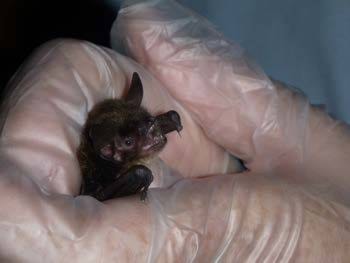Jade Harvey
Columnist
It’s the time of year where the night comes to the forefront. As the the days shorten, the night creeps into our daily lives and we strive to finish work before the darkness descends. Before you know it we’re deep into fall and the celebration of Halloween is upon us. T-shirts, candies and cupcakes are all plastered with the infamous outline of the only flying mammal on earth. The bat.
Let’s face it, most of us rarely think about bats in our day to day lives, (unless one gets trapped in your attic and then you for sure know and think about it). This year I want to challenge you to see the bat as more than just a symbol of the darker side of life, Dracula or something creepy - they are in fact clean, cuddly sociable creatures that do a lot for you without you even knowing.
Despite its seemingly obvious link, it is difficult to find hard evidence for why bats are so strongly entwined with the Halloween holiday. Various biologists and experts have attributed this to the fact they are nocturnal, leaving people to associate them with dark and mysterious things.
Halloween is a holiday connected with things you are scared of, and many people are scared of bats, whether it’s rabies (see below for update) or just their overall appearance (they are actually like miniature winged puppies), we just tend to be frightened of things we don’t understand. I was lucky enough to meet Cori Lauren from the Wildlife Conservation Society of Canada who heads up the Bat Conservation Project in B.C. Even she admitted that despite 43 bat monitoring stations in B.C., (with one in Revelstoke) that they still have little idea where the bats of B.C. hibernate. They are so secretive (but not scary I assure you).
A modern cultural myth has been perpetuated by the obsession over Dracula in the movie industry. Beginning in the 1950s the bat-vampire story has been solidified in our minds by the countless visual representations of Dracula shape-shifting into a bat to travel. A more realistic link is that you are more likely to actually see bats at this time of year because they are swarming and mustering into caves/other hibernation spots for winter.
Historically it is possible that as the Celts celebrated their harvest festival Samhain (which evolved into the modern day Halloween celebration) they lit bonfires. These bonfires attracted insects, which in turn attracted the bats, and so they linked the animals with the celebration going forward.
In total there are around 1,200 species of bat, making up around a quarter of all mammals. We are lucky to have a rich species diversity from here to the South Okanagan with double the number of species than the East have (wahoo!). 16 species have been identified in B.C. and we find 11 of them in the Columbia basin. The number of abandoned mines around the Kootenays is a key habitat - our number of bat species is a true testament to the species diversity of our local habitats here.
So why should you care about these beautiful bats? Well, on a global scale nectar eating bats are the primary pollinators of the caucus and agave plants used to make the world’s supply of tequila and mezcal… So if you enjoy a Margarita or Patron shot then bats are essential to your drinking needs. If you hate tequila, don’t hold it against the bats. It’s not their fault you drank too many Cuevo’s at your Auntie’s birthday and were sick down yourself.
Important to all of us here in Revelstoke is the eating habits of bats. Think our bug problem is bad in summer? Well without the bats it would be significantly worse. Bats are the primary consumer of nighttime insects in our ecosystem. Researchers from Sacramento State University estimated some species of bat can eat the equivalent of two full grocery bags of insects each night. Boom. Thats got to significantly decrease your chance of being bitten by the dreaded mosquitos.
Lets have a quick talk about rabies. It is an old fashioned fear that all bats carry rabies. I’m going to throw down some cold hard facts (from a scientist not the internet). All bats do not carry rabies (less than 0.5 per cent of normal population) , you cannot catch rabies just by being near a bat and bats rarely transmit rabies to other kinds of wildlife. There, said it. Like all wild animals, don’t handle them. If you find an injured bat contact your nearest community bat program by email or phone. The contact details are all listed at www.bcbats.ca along with more detailed information about our B.C. species.
There is a key issue that the Bat Conservation Project of BC want you to be aware of. Half of the 16 species of bats in B.C. are listed as of conservation concern. Multiple threats face these lovely creatures including habitat loss and fragmentation, intentional and unintentional colony disruption, mortality due to wind turbines and the potential of White - Nose Syndrome (WNS).
WNS is a devastating fungus that has nearly wiped out several formerly common bat species in Eastern North America in just a few years. In the east and south below us in Washington scientists are seeing up to 99 per cent mortality within the colony. Bats only produce one young each year and in colonies affected by WNS there is a 50 per cent chance of mortality. WNS hasn’t reached us yet but estimates state that it definitely will in the next ten years.
The main spread of the fungus is likely by bats stowing away in long distance trucks. There are a number of ways to help and these can all be found at the website above. You can also find publications of what to do if you find bats in your property, if you want to build a bat house or want to become involved as a volunteer bat monitor. If you’re a caver you can check out batcaver.org to see how you can help protect these wonders specifically.
And so this Halloween, don’t just see the bat as a spooky, creepy symbol of the supernatural, see them as an integral part of our B.C. and local ecosystem whom without we will see a sad loss to our biodiversity.

